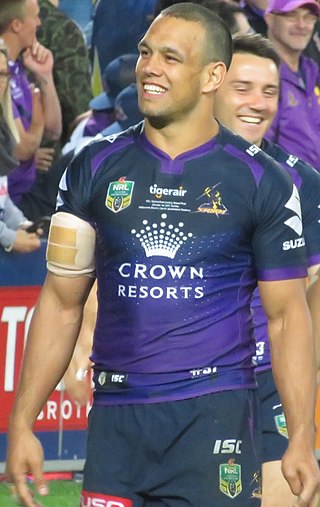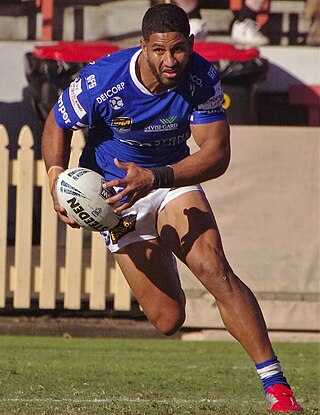
The New Zealand Warriors are a professional rugby league football club based in Auckland, New Zealand that competes in the National Rugby League (NRL) premiership and is the League's only team from outside Australia. They were formed in 1995 as the Auckland Warriors, and are officially known as the One New Zealand Warriors for sponsorship reasons. The Warriors are coached by Andrew Webster and captained by Tohu Harris. The Warriors are based at Go Media Stadium Mt Smart in the Auckland suburb of Penrose.

The Adelaide Rams were an Australian professional rugby league football club based in Adelaide, South Australia. The team was formed in 1995 for the planned rebel Super League competition. The Rams lasted two seasons, the first in the Super League competition in 1997 and the second in the first season of the National Rugby League (NRL) in 1998. The Rams were not a successful club, winning only 13 out of 42 games. However crowd numbers in the first season were the fifth highest of any first-grade club that year, but dwindled to sixteenth in the second season. The Adelaide club was shut down at the end of the 1998 season as a result of poor on-field performances, dwindling crowd numbers, financial losses and a reduction in the number of teams in the NRL. They remain the only team from the state of South Australia to have participated in top-level rugby league in Australia.
Andrew "ET" Ettingshausen is an Australian former professional rugby league footballer who played in the 1980s, 1990s, and early 2000s. He played his first grade Australian club football for the Cronulla-Sutherland Sharks, retiring at the end of the 2000 NRL season having played 328 first grade games for the club, the NSWRL/ARL/SL/NRL record for most games at a single club. This record stood for ten years, before ultimately being broken by Darren Lockyer for the Broncos in 2010.
The 1997 Super League season was a breakaway professional rugby league football competition in Australia and the only one to be run by the News Limited-controlled Super League organisation. Eight teams which had broken away from the existing Australian Rugby League, in addition to the newly created Adelaide Rams and Hunter Mariners, competed over eighteen weekly rounds of the regular season. The top five teams then played a series of knock-out finals which culminated in a September grand final played in Brisbane between the Brisbane Broncos and Cronulla.
The history of the National Rugby League (NRL), the top league of professional rugby league football clubs in Australasia, goes back to December 1997, when it was formed in the aftermath of the Super League war of the mid-1990s. The NRL has, in its relatively brief history, enjoyed growth and record attendance figures.
Paul Gregory Green was an Australian professional rugby league football coach, best known for taking the North Queensland Cowboys to the NRL premiership in 2015, and a professional rugby league footballer who played in the 1990s and 2000s.
John Lang is an Australian former professional rugby league footballer who played in the 1960s, 1970s and 1980s, and coached in the 1980s through to the 2010s. A Queensland State of Origin and Australian international representative hooker, he played his club football in Brisbane with the Eastern Suburbs Tigers and in Sydney with the Eastern Suburbs Roosters. After playing, Lang became a first-grade coach in Brisbane with Easts, then in Sydney with the Cronulla-Sutherland Sharks, Penrith Panthers and South Sydney Rabbitohs. Lang also coached the Australian Super League test team in 1997.
Craig Greenhill is an Australian former professional rugby league footballer. He represented Queensland Maroons in State of Origin, as a second-row.

William Chambers is an Australian rugby league and union footballer who last played for the LA Giltinis in Major League Rugby (MLR) in the United States. After winning two titles with the Melbourne Storm, he retired from Australia's NRL in 2021.

Benjamin Barba is an Australian former professional dual code rugby league & rugby union footballer who last played for St Helens in the Super League. He primarily played as a fullback or five-eighth.
James Tamou is a former professional rugby league footballer who played as a prop and represented Australia and the New Zealand Maori at an international level. Tamou spent most of his career with the North Queensland Cowboys and was a member of their 2015 NRL Grand Final winning side
The Auckland Warriors 1996 season was the Auckland Warriors 2nd season in first-grade. The club competed in Australasia's Australian Rugby League competition. The coach of the team was John Monie while Greg Alexander was the club's captain.
Gerard Beale is a New Zealand international rugby league professional footballer who last played for the St. George Illawarra Dragons in the NRL.
The ARL Premiership was Australia's first grade rugby league competition between 1995 and 1997. It replaced the previous competition, the New South Wales Rugby League premiership, after the competition expanded to 20 teams with the admittance of four additional clubs to the competition; the North Queensland Cowboys, South Queensland Crushers, Western Reds, and Auckland Warriors.

Nene Macdonald is a Papua New Guinean professional rugby league footballer who plays as a winger or centre for the Leeds Rhinos in the Super League and Papua New Guinea at international level.

Fa'amanu Brown is a Samoa international rugby league footballer who currently plays for the Newcastle Knights in the National Rugby League (NRL). His positions are five-eighth, hooker, halfback and lock.
The 2015 New Zealand rugby league season was the 108th season of rugby league that had been played in New Zealand. The main feature of the year was the National Competition, which was won by the Counties Manukau Stingrays.
Top-level rugby league in 2014 centred on Australasia's 2014 NRL Auckland Nines, 2014 NRL season and the Super League XIX. High-profile representative competitions included the 2014 Rugby League Four Nations and the 2014 State of Origin series.
The Queensland derby refers to rugby league matches between National Rugby League (NRL) clubs, the Brisbane Broncos and North Queensland Cowboys, first contested in 1995. The rivalry features the two longest-serving Queensland based clubs in the ARL/Super League/NRL competitions. They have met 53 times since 1995, with Brisbane leading the head-to-head series 35–18; with two drawn matches.
The 2017 NRL season was the 110th season of professional rugby league in Australia and the 20th season run by the National Rugby League. The season started in New Zealand with the annual Auckland Nines, and was followed by the All Stars Match, which was played at McDonald Jones Stadium in Newcastle, and the World Club Series. It marked the last time that the Anzac Test and City vs. Country representative matches were played.







